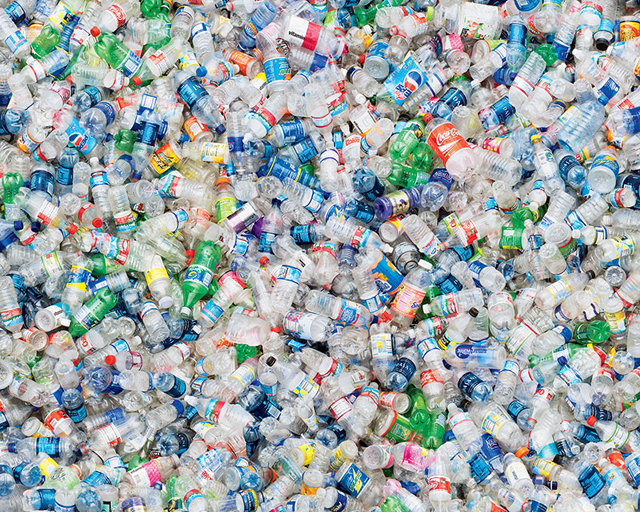sierraclub.org - sierra magazine - january/february 2011 - beyond oil in 20 years
Here's how to get there
By Paul Rauber
Photo illustrations by Chris Jordan from Running the Numbers: An American Self-Portrait

Oil Barrels, 2008 (60 x 60 inches)
Depicts 28,000 42-gallon barrels, representing the amount of oil consumed in the United States every two minutes. | Photo illustration by Chris Jordan, courtesy of Kopeikin Gallery
America is often said—by President Barack Obama, former president George W. Bush, Sierra Club executive director Michael Brune, and many others—to be addicted to oil. It's a convenient shorthand diagnosis of a nation suffering from an unhealthy dependency on 19.54 million barrels per day of liquefied plant and animal matter from the Mesozoic era. That works out to almost three gallons every day for every man, woman, and child in the country. Remember the harrowing footage of oil spewing out of BP's Macondo well? The United States uses more than four times the total amount of the BP spill daily.
And for good reason: The easy portability of oil's explosive energy has made us the most mobile humans in history. Fears of peak oil notwithstanding, it is also still very cheap. The gallon of gas that was $2.30 in real dollars in 1960 cost only $2.73 in 2010. No surprise, then, that petroleum powers 95 percent of all transportation in the United States.
Like addicts, we persist in using oil even though it hurts us in many ways. More than half of our oil is imported, with a third of that amount coming from countries at high or very high risk for instability. Importing all that fuel costs our economy $180 billion a year. Outside the Middle East, the easy oil is gone, and the remainder comes from areas where spills can be environmentally catastrophic, like deep in the Gulf of Mexico or in the high Arctic. Oil has led us into disastrous, costly wars in Afghanistan and Iraq. (Osama bin Laden's original beef with the United States, remember, was the presence of U.S. troops in Saudi Arabia.) And burning petroleum accounts for 42 percent of all energy-related carbon dioxide emissions in the United States, contributing greatly to a future of climate chaos.
Breaking an addiction is a wrenching process. And quitting oil certainly could be ugly, especially if we're cut off suddenly, as a result of another embargo by oil-producing states, say, or by stratospheric price hikes due to declining reserves. But a future without oil doesn't have to mean going cold turkey or fighting for fill-ups in a Mad Max world. Alternatives already exist for most uses of oil, and adopting them will improve our lives in many ways beyond slowing climate change.
The Sierra Club's Beyond Oil campaign proposes to move the United States off oil in the next 20 years. The following pages sketch out how we could do so. Some solutions require policy changes in Washington, D.C., and the statehouses, but many are purely up to you—the purchases you make, how you heat your home, and especially how you get from place to place. Personal transportation—by car, light truck, and airplane—accounts for nearly 50 percent of U.S. oil use, moving freight for another 18 percent; combined, they require nearly twice as much oil as we produce domestically. For every Macondo, it takes two more wells in Saudi Arabia, Indonesia, or Venezuela to fuel our trips to work and soccer practice.
The good news is that we already know how to get around without oil. "This is not rocket science," Representative Ed Markey (D-Mass.) once said. "It's auto mechanics." Twenty years out, we may find that oil was not so much an addiction as a bad habit that we've happily outgrown.

Plastic Bottles, 2007 (60 x 120 inches)
Depicts 2 million plastic bottles, the number used in the United States every five minutes. | Photo illustration by Chris Jordan, courtesy of Kopeikin Gallery

Detail from Plastic Bottles
The U.S. Conference of Mayors calculates that it takes 1.5 million barrels of oil to make the plastic water bottles used in the United States in one year. Nationally, only one in four plastic bottles is recycled. | Photo illustration by Chris Jordan, courtesy of Kopeikin Gallery
Cars and Light Trucks
(8.81 million barrels a day)
The no-brainer approach to reducing the amount of oil cars and light trucks consume is to drive our cars and trucks less. When gas approached $4 a gallon in 2008, consumption dropped by 900,000 barrels a day. People didn't stop going places; they just got there by public transit, cycling, or (gasp!) walking.
The other easy solution is to make vehicles that use less gas. Automobile fuel-efficiency basically remained unchanged from 1975 to 2007. (Auto engineering did improve in that period, but those advances overwhelmingly entailed increasing the horsepower, not the mileage, of cars and SUVs.) Last April, Obama signed a new fuel-efficiency standard mandating that light-duty vehicles average 35 miles per gallon by 2016. It will save, over the life of cars built between 2012 and 2016, 1.8 billion barrels of oil.
Much bigger reductions are to come in the years after 2016. Last October, the Obama administration announced that it wants to see an annual decrease in car and truck emissions of between 3 and 6 percent from 2017 to 2025. This would result in vehicles averaging 47 to 62 mpg by 2025 and could be accomplished, says a report by John DeCicco of the University of Michigan, through the use of lightweight steel, hybrid drives, efficient diesels, and aerodynamic styling. The Sierra Club and other groups in the Go60mpg campaign (go60mpg.org) are urging the EPA to adopt the highest possible standard, noting that a 60-mpg level would save 44 billion gallons of fuel by 2030. DeCicco, in fact, believes that an average of 74 mpg is achievable by 2035.
While U.S. carmakers were willing to go along with Obama's 35-mpg-by-2016 standard, they're likely to balk at ambitious further improvements. Fifty-nine percent of Americans, on the other hand, favor a 60-mpg goal, according to a Consumer Federation of America poll, with 62 percent saying they'd buy a car getting such mileage if they could recover the extra cost over a five-year period—and both MIT and the National Academy of Sciences agree that they would.
Of course, drivers don't have to wait 25 years for super-fuel-efficient vehicles. They can go to the dealer today and buy a standard Prius (50 mpg, according to the EPA), a Smart car (36 mpg), a Honda Civic (42 mpg), or any of a dozen other models achieving 30-plus mpg. By the time you read this, Chevy will have begun selling its gas-electric Volt (not yet rated) and Nissan its Leaf, the first mass-market car for which miles per gallon of gas no longer makes sense as a measurement, because it's all-electric. Far cheaper, however, is the zero-gallons-per-mile bicycle, guaranteed to be available at a bike shop near you.

Plastic Bags, 2007 (60 x 72 inches)
Depicts 60,000 plastic bags, the number used in the United States every five seconds. | Photo illustration by Chris Jordan, courtesy of Kopeikin Gallery

Detail from Plastic Bags
Could the ubiquitous plastic bag be heading for the landfill of history? From San Francisco to American Samoa, they're now being banned or restricted. A five-cent-per-bag charge in Washington, D.C., reduced the number handed out per month from 22.5 million to 3 million. | Photo illustration by Chris Jordan, courtesy of Kopeikin Gallery
Big Trucks and buses
(2.36 million barrels a day)
Heavy-duty trucks still average the same 6 mpg they did 40 years ago, so there is plenty of room for improvement. The Obama administration is developing the first-ever fuel-efficiency standards for medium- and heavy-duty vehicles; Go60mpg wants to see improvements of at least 35 percent for big rigs and 20 percent for other trucks by 2017—all possible with existing technology.
But trucks don't need to run on oil at all. While electricity is currently an implausible fuel source for heavy-duty vehicles because of the size and weight of the batteries that would be required, compressed natural gas (CNG) and liquefied natural gas (LNG) appear to be workable substitutes.
Natural gas produces one-quarter less CO2 than diesel and can be cheaper per mile as well. If conventional diesel-powered heavy-duty trucks were replaced with natural gas vehicles as they retired, we could save 1.2 million barrels of oil a day. Already, 41,000 trucks and buses run on CNG, and 2,600 on LNG. Powering trucks with natural gas is supported by bipartisan bills in both houses of Congress, mostly via increasing and extending tax credits for natural gas.
(Natural gas is not without its own problems. While far cleaner than diesel, it still produces CO2, and its extraction via the process known as "fracking" can contaminate water supplies. Many environmentalists see it as a "bridge fuel" between oil and truly renewable power sources.)
An alternative to reinventing the truck is to shift long-distance freight to trains, which are more energy efficient. Already, UPS has vastly shrunk its carbon footprint by sending containers by rail as far as possible before loading them on trucks. Even-higher efficiency would be achieved by electrifying our rail system, as Europe has already done. Since passenger trains share rail corridors with freight in much of the country, electrification would enable oil-free passenger service as well.
Air Travel
(1.37 million barrels a day)
Since the 1940s, the number of miles traveled by air has increased every year except 1991 and 2001. Pre-recession, air travel was growing at a rate of about 5 percent per year. Jet fuel accounts for 10.5 percent of U.S. transportation fuel, though planes are becoming more energy efficient and being flown in a more efficient way. Some carriers, for instance, are reducing their top speeds and using longer, smoother "continuous descent" landings to save fuel. Still, efficiency gains can't keep pace with the increase in passenger miles. Some airlines, like Virgin, are experimenting with biofuel as a replacement for jet fuel (a highly processed form of petroleum), but unless we want to plant the entire Southeast with soybeans to sustain our flying habit, that option has its limits.
Reducing the amount of oil used in aviation may come down to flying less. Many companies are now using teleconferencing to trim their travel budgets; who knows, it might work with Aunt Lucille too.
In 2009, the independent Committee on Climate Change, which advises the British government, suggested that the U.K. consider measures including a carbon tax on flying and a limit on future runway expansion. A more politically palatable approach in the United States would be offering an alternative to flying in the form of high-speed rail. As part of the 2009 stimulus bill, Congress allocated $8 billion to intercity rail projects, with priority going to high-speed service.
Heating
(.89 million barrels a day)
It's been decades since most of the country moved on to cleaner fuels for heat, but some 8 million buildings still burn oil, three-quarters of them in the Northeastern states. In New York City, 9,000 buildings (including landmarks like the Flatiron Building and the Dakota) burn No. 4 and No. 6 oil, the dirtiest sludge from the bottom of the oil barrel, making them major emitters of deadly soot in addition to CO2.
New York is starting to do something about it. Mayor Michael Bloomberg signed a bill last August requiring that 2 percent biodiesel be added to the billion gallons of heating oil the city uses annually, starting in October 2012. Better yet would be getting off oil altogether and converting to cleaner—and often cheaper—natural gas. In remote areas where natural gas lines are not economical, many residents are switching to propane, which emits about 20 percent less carbon dioxide than oil per Btu. To encourage the changeover, the government could offer financial incentives to owners of homes and commercial buildings to get off oil for good.
Electricity, Military, Plastic, and Other Uses
(6.11 million barrels a day)
The last few drops in the U.S. oil barrel go to electricity generation, the military, plastic products, and other uses. Happily, burning oil to produce electricity is now even more of a remnant concern than burning it for heat; in 2009, it accounted for less than 1 percent of the nation's megawatts. Oil could be replaced by other, cleaner fuels and no one would notice.
The military's appetite for oil accounts for about 1 percent of national usage. No other sector of society has such direct experience with the more extreme consequences of U.S. oil dependence, and in October, Navy secretary Ray Mabus announced a goal of powering the U.S. Navy and Marine Corps with 50 percent renewable energy by 2020. "Getting a gallon of gasoline to a Marine at a forward operating base in Afghanistan is not easy," he said in a speech in July. "For every 24 convoys, we lose a marine, a soldier, a sailor, or an airman: one in every 24 convoys. That is too high a price to pay for power."
Then there are those myriad consumer and industrial uses of oil that can be summed up in one word: plastic. Its cheapness and versatility make it nearly ubiquitous in our culture, not to mention our environment—witness the huge "garbage patches" of floating plastic junk in the world's five oceanic gyres. Some common uses, however, are on their way out. Last September, frantic lobbying by the plastic-bag industry stopped the California State Senate from banning plastic bags statewide, but San Francisco and a number of other cities have passed local prohibitions. (San Francisco's ban alone has cut the number of plastic bags by 60 million per year.) Other states and cities are considering banning the bags or, as New York City mayor Bloomberg has proposed, achieving a similar effect by charging 5 cents for them.
Many plastic items turn out to have perfectly viable non-petroleum substitutes. Plastic food packaging is being phased out in the increasing number of cities with municipal composting systems, which often require restaurants and fast-food operations to use vegetable-based food containers that get your takeout home but don't last forever in a landfill.
But what about the other things made out of oil, like life jackets, artificial limbs, shower curtains, surfboards, and bike tires? Maybe replacement materials for these and other petro-based products can be found, or maybe they can't. The goal, remember, is to stop burning oil to prevent our climate from going haywire. If we do that, we can keep the crayons, umbrellas, and lipstick. Besides, in the course of ending our oil habit, we're going to need a whole lot of bike tires.
Paul Rauber is a senior editor at Sierra.
CHRIS JORDAN is an artist who lives in Seattle. (See "EarthBeat," for an interview with Jordan.)
This article was funded by the Sierra Club's Climate Recovery Partnership and Beyond Oil campaign.
This article has been corrected subsequent to publication.